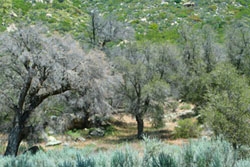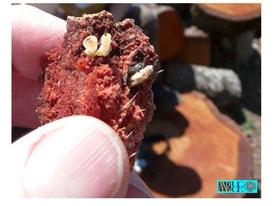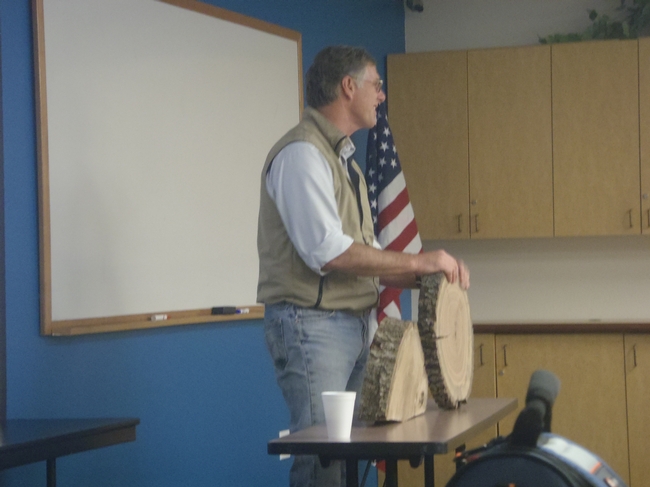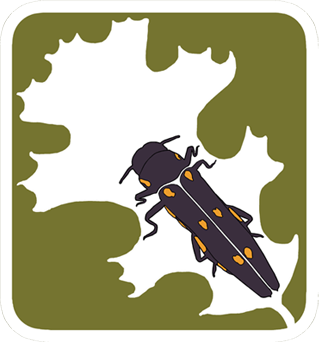The goldspotted oak borer (GSOB; Agrilus auroguttatus) continues to attack and contribute to the high mortality of tens of thousands of oaks in San Diego County and the threat to oaks throughout southern California remains a considerable concern. In effort to inform professionals who are responsible for the stewardship of oaks and oak woodlands, a series of workshops has been offered in six southern California counties in which oaks may be at risk: Ventura, Los Angeles, Riverside, San Bernardino, Orange and San Diego. The overlying objective was to spread the knowledge of goldspotted oak borer and minimize the spread of this non-native insect into new areas. These day-long events offered multi-agency presentations, hands-on displays, outreach materials and in some locations, short field trips.


Figure 1. Dead oak trees due to GSOB Figure 2. Two Adult GSOB on penny
(Photo source: Tom Coleman, USDA Forest Service) (Photo source: Tom Coleman, USDA Forest Service)
In cooperation, the USDA Forest Service, CAL FIRE, and the University of California have partnered with other local agencies, tribes and organizations to provide these workshops. Presenters at each session were coordinated from a cadre of specialists and researchers. Key speakers included Tom Coleman, Paul Zambino, Sheri Smith, Larry Swann, Lisa Fischer and Matthew Bokach (USDA Forest Service and Forest Health Protection); Tom Smith, Kim Camilli and Kathleen Edwards (CAL FIRE);Tom Scott, Doug McCreary, Jim Downer and Kevin Turner (University of California Cooperative Extension); and Vanessa Lopez (PhD candidate in the Entomology Department, UC Riverside). Introductory workshops were held monthly from September 2010 through February 2011. Topics covered were:
- GSOB history and distribution
- GSOB identification and biology
- Ecological and economic impacts of infested oaks and oaks at-risk
- Integrated best management practices for GSOB infested and at-risk oak woodlands
- How to prepare for potential outbreak
- Utilization of GSOB infested oak wood
- Restoring oak woodlands impacted by GSOB


Figure 3. Larvae Feeding Galleries, seen in cambium Figure 4. GSOB larvae in firewood (Photo source:
of oak wood cross-section (Photo source: Tom Scott, UC Cooperative Extension)
Kim Camilli, CAL FIRE)
In early May 2012, two additional workshops were held to provide updates from on-going research, best management practices and mitigation and education efforts. The session on May 1st was held in Altadena in partnership with the Los Angeles County Fire Department-Forestry Division and the County Parks and Recreation Department. The following workshop, held on May 2nd, was hosted in partnership with the Pechanga Band of Luiseño Indians in Temecula.
Information Highlights:
- The goldspotted oak borer in an introduced, non-native beetle attacking and killing coast live oak (Quercus agrifolia), California black oak (Quercus kelloggii), and canyon live oak (Quercus chrysolepis) trees in San Diego County.
- The adult goldspotted oak borer (GSOB) Agrilus auroguttatus is a small, bullet-shaped beetle about 10mm (0.4 in.) long and has six golden yellow spots on its dark green forewings.
- Mature larvae are white, legless, slender and about 18mm (0.75 in.) long with two pincher-like spines at the tip of the abdomen. Larvae feed under the bark on the trunk and larger branches.
- Larval feeding kills patches and strips of cambium tissue beneath the bark, which causes dark staining and sap flow. The larvae pupate in the outer bark and leave D-shaped exit holes about 1/8 in. wide when they emerge.
- GSOB produce only one beetle generation per year.
- The goldspotted oak borer’s peak flight and breeding season is May through October.
- There is on-going research being conducted on biological and chemical GSOB control methods for preventative management; trees at various degrees of infestation; and the wood from infested, dead and felled trees.
- Currently, there are no effective treatments that can eradicate GSOB once it becomes established.
- Goldspotted oak borer larvae and pupae can survive under the bark of wood from large branches and trunks for up to a year after a tree dies.
- Currently, best management practices to minimize introduction of GSOB to new areas is to let wood cure at least two years after the tree dies before moving firewood from infested areas or grind wood into 3-inch particles.
- Before any type of treatment on oaks is initiated for GSOB infested trees or as a preventative measure on high-valued trees, a management plan should be developed first.
- There are no quarantines or zones of infestation in place by statewide authorities for GSOB; however, in 2011 the California Pest Council established the California Firewood Taskforce, a coalition of stakeholders that initiates and facilitates efforts within the state to protect our native and urban forests from invasive pests that can be moved on firewood.
- The Early Warning System is a citizen scientist program established to enlist the help of those concerned about oaks for the purpose of identifying oak tree health in southern California urban and woodland areas.
- Information and resources may be found on the Goldspotted Oak Borer website, www.gsob.org. To stay informed of current news, information and future training opportunities, we recommend you join the GSOB email list.

(Photo source: Lorin Lima, UC Cooperative Extension-San Diego)
Nearly 500 professionals attended these workshops. Findings from follow-up workshop surveys indicate that potentially more than 2,600 others will learn about GSOB through outreach extended by workshop participants. Although evaluation and survey responses point towards a successful series of GSOB workshops, the threat of further goldspotted oak borer attacks remains. As the peak emergence and flight season occurs during the same time of year of increased vacation travel and camping in southern California, we are all encouraged to share the news about GSOB and it’s threat to oaks with others along with the message to not move firewood – “Buy It Where You Burn It.”
For more information:
Goldspotted Oak Borer website: http://www.gsob.org
California Firewood Task Force: http://www.firewood.ca.gov
Goldspotted Oak Borer - The Center for Invasive Species Research, UC Riverside:
http://cisr.ucr.edu/goldspotted_oak_borer.html
Goldspotted Oak Borer – UC Statewide Integrated Pest Management: http://www.ipm.ucdavis.edu/NATURAL/index.html